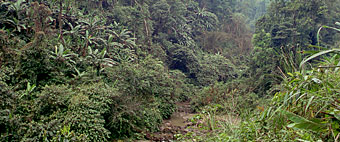| PETERVANHAM.COM BIOGRAPHIES BOOKS MUSIC / FILM PUBLICATIONS & LECTURES NORTHEAST INDIA WESTERN HIMALAYAS PHOTO-ARCHIVES UPCOMING CONTACT |
|||||
| TRAVEL TO ARUNACHAL WITH THE MOST EXPERIENCED DONYI HANGO TOURS, ITANAGAR, ARUNACHAL |
|||||
ARUNACHAL PRADESH
The population of Arunachal Pradesh, 858,392 according tothe 1991 census, is made up of over 82 tribes and sub-tribes of Indo-Mongoloid origin. All these groups have their distinctive social and cultural identities, speaking different languages and dialects of the Tibeto-Burma family and following different beliefs and customs. The territory can be conveniently divided into three main cultural zones:
To the first zone belong the Buddhist or near-Buddhist groups of the westernmost parts (Tawang, West Kameng), other small tribes along the northern frontier, and theKhamtis and the Singphos in the foothills of the eastern parts.
These Buddhist and near-Buddhis groups have elements of civilization considerably influenced by Tibet and Burma. The Monpas and the Sherdukpens are followers of Tibetan buddhism while the Khamptis and Singphos, who are Buddhists of Burmese affiliation, have migrated from the Irrawady valley in comparatively recent times and lived in close proximity to the plains of Assam. The Buguns (Khowas), the Hrussos (Akas) and the Dhammais (Mijis), though not Buddhists themselves, have imbibed many cultural elements from their Buddhist neighbors.

Again, there have been contacts with the plains of Assam at various levels and a kind of patois of Assamese language-sometimes designated as Nefamese, has served as lingua franca for communication among different groups.
• The people and the landscape
• The Apa Tani Plateau
• The journey from Bhalukpong to Tawang
• The Wanchos, Noctes and Tutsas at Tirap District
(closed to foreigners at present)
• The jungles of Siang and Subansiri Districts
All these highlights and more are the subject of two books by Peter van Ham:
THE SEVEN SISTERS OF INDIA
Tribal Worlds Between Tibet And Burma
THE HIDDEN WORLD OF THE NAGA
Living Traditions In Northeast India And Burma
IN DEN BERGEN DER KOPFJÄGER
Indiens Wilder Nordosten
ALL THREE MAY BE ORDERED DIRECTLY FROM THIS SITE.
on Northeast India:
NAGALAND, MANIPUR, MIZORAM,
TRIPURA, MEGHALAYA, ASSAM,
Christoph von Fuerer-Haimendorf
& Verrier Elwin